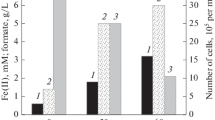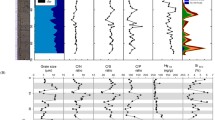Abstract
Although psychophiles, which live in cold conditions (<20°C), are very common amongst a wide variety of habitats, studies of Fe(III) reduction and mineral formation by the microbes are rare. A psychorotolerant Fe(III)-reducing bacterium (W3-6-1,Shewanella baltica) isolated form ocean sediments were used to study iron reduction and mineral formation under various growth conditions. The psychorotolerant bacterium was able to use lactate, formate, and hydrogen as electron donors to reduce iron at temperatures between 0°C and 37°C. The W3-6-1 was also capable of reducing a toxic Co(III)-EDTA as the sole electron acceptor. The atmosphere and chemical conditions exhibited strong influence on the mineral types in an anaerobic culture. Magnetite formation was dominant under N2 and H2 atmospheres. Siderite formation was dominant under an H2−CO2 (20∶80) atmosphere. A mixture of magnetite and siderite was formed under an N2−CO2 (80∶20) atmosphere. This study indicates that microbial Fe(III) reduction may play important roles in iron and carbon fate in cold natural environments on a geological time scale.
Similar content being viewed by others
References
Bell, P.E., Mills, A.L. and Herman, J.S., 1987, Biogeochemical conditions favoring magnetite formation during anaerobic iron reduction. Applied and Environmental Microbiology. 53, 2610–2616.
Boone, D.R., Liu, Y., Zhao, Z., Balkwill, D.L., Drake, G.R., Stevens, T.O., and Aldrich, H.C., 1995,Bacillus infernus-sp. Nov.: An Fe(III) and Mn(IV) reducing anaerobe from the deep terrestrial subsurface. International Journal of Systematic Bacteriology, 45, 441–448.
Bowman, J.P., McCammon, S.A., Nichols, D.S., Skerratt, J.H., Rea, S.M., Nichlos, P.D., and McMeekin, T.A., 1997,Schwanella gelidimarina sp. nov. andSchwanella frigidimarina so. nov., novel Antarctic species with the ability to produce eicosapentanoic acid (20w3) and grow anaerobically by dissimilatory Fe(III) reduction. International Journal of Systematic Bacteriology, 47, 1040–1047.
Coates, J.D., Lonergan, D.J., Jenter, H. and Lovley, D.R., 1996, Isolation of Geobacter species from diverse sedimentary environments. Applied and Environmental Microbiology, 64, 1504–1509.
Ferris, F.G., Wiese, R.G. and Fyfe, W.S., 1994, Precipitation of carbonate minerals by microorganisms: Implications for silicate weathering and the global carbon dioxide budget. Geomicrobiology Journal, 12, 1–13.
Fredrickson, J.K., Zachara, J.M., Kennedy, DW., Dong, H., Onstott, T.C., Hinman, N.W. and Li, S., 1998, Biogenic iron mineralization accompanying the dissimilatory reduction of hydrous ferric oxide by a groundwater bacterium. Geochimica et Cosmochimica Acta. 62, 3239–3257.
Heijman, C.G., Holliger, C., Glaus, M.A. and Schwarzenbach, R.P., 1983, Abiotic reduction of 4-chlorobenzene to 4-chloroaniline in a dissimilatory iron-reducing enrichment culture. Applied Environmental Microbiology, 59, 4350–4353.
Heijman, C.G., Grieder, E., Holliger, C. and Schwarzenbach, R.P., 1995. Reduction of nitroaromatic compounds coupled to microbial iron reduction in laboratory aquifer columns. Environmental Science and Technology, 29, 775–783.
Hobbie, J.E. 1988, A comparison of the ecology of planktonic bacteria in fresh and salt water. Limnology and Oceanography, 33, 750–764.
Hobbie, J.E., Daley, R.J. and Jasper, S., 1997, Use of nucleopore filters for counting bacteria by fluorescence microscopy. Applied and Environmental Microbiology, 33, 1225–1228.
Juniper, S.K., Nartineu, P., Sarrazin, J. and Gelinas, Y. 1995 Microbial floc associated with nascent hydrothermal activity on coaxial segment, Juan-De-Fuca Ridge. Geophysical Research Letters, 22, 179–182.
Leonardo, M.R., Moser, D.P., Barbieri, E., Branter, C.A., MacGregor, B.J., Paster, B.J., Stackebrandt, E. and Nealson, K.H., 1999,Shewanella pealeana, sp. nov., a member of the microbial community associated with the accessory nidamental gland of the squidLoligo pealei. International Journal of Systematic Bacteriology, 49, 1106–1109.
Liu, S.V., Zhou, J., Zhang, C., Cole, D.R., Gjadarziska-Josifovska, M. and Phelps, T.J., 1997, Thermophilic Fe(III) Reducing bacteria from the deep subsurface: The evolutionary implications. Science, 277, 1106–1109.
Lovley, D.R., 1990, Magnetite formation during microbial dissimilatory iron reduction. In: Frankel, R.B. and Blakemore, R.P. (eds.), Iron Biominerals, Plenum Press, p. 151–166.
Lovley, D.R., 1991, Dissimilatory Fe(III) and Mn(IV) reduction. Microbial Review, 55, 259–287.
Lovley, D.R., 1993, Dissimilatory metal reduction. Annual Review of Microbiology, 47, 263–290
Lovely, D.R., 1995, Bioremediation of organic and metal contaminants with dissimilatory metal reduction. Journal of Industrial Microbiology, 14, 85–93.
Lovley, D.R., Stolz, J.F., Nord, G.L. Jr. and Phillips, E.J.P., 1987, Anaerobic production of magnetite by a dissimilatory iron-reducing microorganism. Nature, 330, 252–254.
Lovley, D.R., Phillips, E.J.P., Gorby, Y.A., Landa, E.R., 1991, Microbial reduction of uranium. Nature, 350, 413–416.
Lovley, D.R. and Phillips, E.J.P., 1992, Bioremediation of uranium contamination with enzymatic uranium reduction. Environmental Science and Technology, 26, 2228–2234.
Makemson, J.C., Fulayfil, N.R., Landry, W., Van Ert, L.M., Wimpee, C.F., Widder, E.X. and Case, J.F., 1997,Shewanella woodyi sp. nov., an exclusively respiratory luminous bacterium isolated from the Alboran Sea. International Journal of Systematic Bacteriology, 47, 1034–1039.
Morita, R.Y., 1975, Psychrophilic bacteria. Bacteriology Review. 39, 144–167.
Nealson, K.H., and Myers, C.R., 1990, Iron reduction by bacteria: A potential role in the genesis of banded iron formations. American Journal of Science, 290, 35–45.
Nealson, K.H. and Saffarini, D., 1994, Iron and manganese in anaerobic respiration: Envrionmental significance, physiology, and regulation. Annual Review of Microbiology, 48, 311–343.
Oremland, R.S., 1994, Biogeochemical transformation of selenium in anoxic environments. In: Frankenberger, W.T.J. and Benson, S.N. (eds.), Selenium in the environment. Marcel Dekker, Inc. New York, N.Y., p. 389–419.
Parkes, R.J., Cragg, B.A., Bale, S.J., Getliff, J.M., Goodman, K., Rochelle, P.A., Fry, J.C., Weightman, A.J. and Harvey, S.M. 1994, Deep bacterial biosphere in Pacific Ocean sediments. Nature, 371, 410–413.
Pedersen, K., 2000, Exploration of deep intraterrestrial microbial life: current perspectives. FEMS Microbiology Letters, 185, 9–16.
Phelps, T.J., Raione, E.G., White, D.C. and Fliermans, C.B., 1989, Microbial activity in deep subsurface environments. Geomicrobiology Journal, 7, 79–91.
Reichelt, T.J. and Baumann, P., 1974, Effect of sodium chloride on growth of heterotrophic marine bacteria. Archives of Microbiology, 97, 329–345.
Roden, E.E. and Zachara, J.M., 1996, Microbial reduction of crystalline iron (III) oxides: influence of oxide surfaces are and potential for cell growth. Environmental Science and Technology, 30, 1618–1628.
Roh, Y. and Moon, H.S., 2000, Microbiol synthesis of magnetite powder by iron reducing bacteria. Journal of Mineralogical Society of Korea. 13, 65–72.
Stapleton, R. D. Jr., McDonel, P. E., Sabree, J. L., Lies, D. P., Nealson K. H., Phelps, T. J., Palumbo, A. V. and Zhou, J., 2001, Low temperature iron reduction byShewanella species isolated from diverse marine environments. Extremophiles (In Press).
Stookey, L.L., 1970, Ferrozne-a new spectrometric reagent for iron. Analytical Chemistry, 42, 779–781.
Vargas, M., Kashefi, K., Blunt-Harris, E.L. and Lovley, D.R., 1998, Microbiological evidence for Fe(III) reduction on early earth. Nature, 395, 65–67.
Venkateswaran, H., Dollhopf, M.E., Aller, R., Stackebrandt, E. and Nealson, K.H., 1998,Shewanella amazonesis so. nov., a novel metal-reducing falculative anerobe from Amazonian shelf muds. International Journal of Systematic Bacteriology, 48, 965–972.
Vogel, B.F., Jorgensen, K., Christensen, H., Olsen, J.E., and Gram, L., 1997, Differentiation ofShewanella putrefaciens andShewanella alga on the basis of whole-cell protein profiles, ribotyping, phenotypic characterization, and 16S rRNA gene sequence analysis. Applied and Environmental Microbiology, 63, 2189–2199.
Walker, J.C.G., 1984, Subtoxic diagenesis in banded iron formation. Nature, 309, 340–342.
Zhang, C., Liu, S.V., Logan, J., Mazumder, R., and Phelps, T.J. (1996) Enhancement of Fe(III), Co(III) and Cr(VI) reduction at elevated temperatures and by a thermophilic bacterium. Applied Biochemistry and Biotechnology, 57/58, 923–932.
Zhang, C., Liu, S., Phelps, T.J., Cole, D.R., Horita, J., Fortier, S.M., Elless, M.P. and Valley, J.W., 1997, Physiochemical, mineralogical and isotopic characterization of magnetite-rich iron oxides formed by thermophilic iron reducing bacteria. Geochemica et Cosomochimica Acta, 61, 4621–4632.
Zhang, C., Vali, H., Romanek, C.S., Phelps, T.J. and Liu, S.V., 1998, Formation of single-domain magnetite by a thermophilic bacterium. American Mineralogist, 83, 1409–1418.
Zhang, C., Stapleton, R.D., Zhou, J., Palumbo, A.V. and Phelps, T.J., 1999, Iron reduction by psychrotrophic enrichment cultures. FEMS Microbiology Ecology, 30, 367–371.
Author information
Authors and Affiliations
Corresponding author
Rights and permissions
About this article
Cite this article
Roh, Y., Moon, HS. Iron reduction by a psychrotolerant Fe(III)-reducing bacterium isolated from ocean sediment. Geosci J 5, 183–190 (2001). https://doi.org/10.1007/BF02910302
Received:
Accepted:
Issue Date:
DOI: https://doi.org/10.1007/BF02910302




